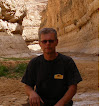11.07.2013 – 14.07.2013
The Journey: Nazca – Chauchilla – Nazca – Lima (565 km).
Near the town of Nazca in the Andean foothills there are strange lines and shapes on the plateau of 400 square kilometers. The mystery of those lines and shapes is fully unsolved till now.
Here in this rock desert there are hundreds and hundreds of straight lines and geometric shapes and nearly 70 images of animals and plants. Different sources give different numbers, of course.

The technology of making of the lines is simple. Here in this picture all the big and small stones are removed from the area of a half -meter width so that the lighter line of the ground has appeared. Some of the lines are, of course, wider than half a meter, but the technology is the same. The brighter spot is the stone-free ground.
The lines were discovered in the twenties of the last century. There are quite a lot of different theories about them. It was thought at the beginning that this is an Inca road network, then – that it is an astronomical calendar, because the two straight lines run exactly to the direction of summer and winter solstices. It has been believed that it is a religious place, and, of course, is that this is an UFOs landing site.
This latter theory was confirmed some time ago by Erich von Daniken`s film "Future Memories". The oldest lines come probably from 500 BC, but most of them belong to the period from 200 BC to 500. It is thought that very likely the lines are made by the former Nazca civilization The best overview to see the figures is, of course, from the high air, flying in a plane, and thanks to airplanes, after all, they were discovered. How many of them there are, which shapes they form etc.

But if you still do not want to fly or the weather is cloudy and no flights because of that – then one can get the basic idea of the drawings from an observation tower that has been built by the road of Panamericana and is named - "Mirador Observation Tower."


Something can be observed also in the neighboring higher hills.

Nazca is a small town of 27 thousand inhabitants. The main road that crosses the city is, of course, Panamericana. Besides the main attraction - the plateau with the lines – in this area there are also other interesting traces of the Nazca civilization.

Puquios - An underground aqueduct built by Nazca civilization and is in use even today.


Quite a decent stone staircase – to get downwards.


Nascast 30 kilometers southwards from Nasca - there is one more trace of Nazca civilization - Chauchilla Cementery.


In previous centuries, the vaults have been heavily devastated and now the open vaults are covered with roofs.

Tombs and mummies are sewn into fabric, all are in a sitting positio.




Sunset in Chauchilla

As to flying over the lines - the previous day the weather was foggy in the morning, and there were no flights, and when the weather cleared up, there were no more flights available on the same day.

Next morning.

The plane is not allowed to be older than 15 years and there must be two pilots. And by the way – the weight of each passenger was written down. So – all kinds of precautions for safety.

The instructions are in the seat pockets.

And there is also an empty bag in the seat pockets.

Meanwhile the pilots come, the engine is turned on, then a longer conversation between the pilots and probably the air traffic controllers takes place.
Next – the engine is turned off. Fortunately after twenty-minutes of waiting we take off the ground.



The trajectory is anything other than a straight line. Every object at first could be viewed from one side and then from the other side. And we fly to the next image and again have a look at the shape from one side and from the other side. And so on and on.

“Astronaut” on the mountainside.

The shape of the Hummingbird clear and sharp.

Panamericana, and the gazebo. And narrower and broader lines.

Nazca city before landing. The empty bag was not used but the flight still gave a pretty good shaking.

In the parking lot of Nazca Airport, and one can travel by this kind of car as well.
Continued...



No comments:
Post a Comment